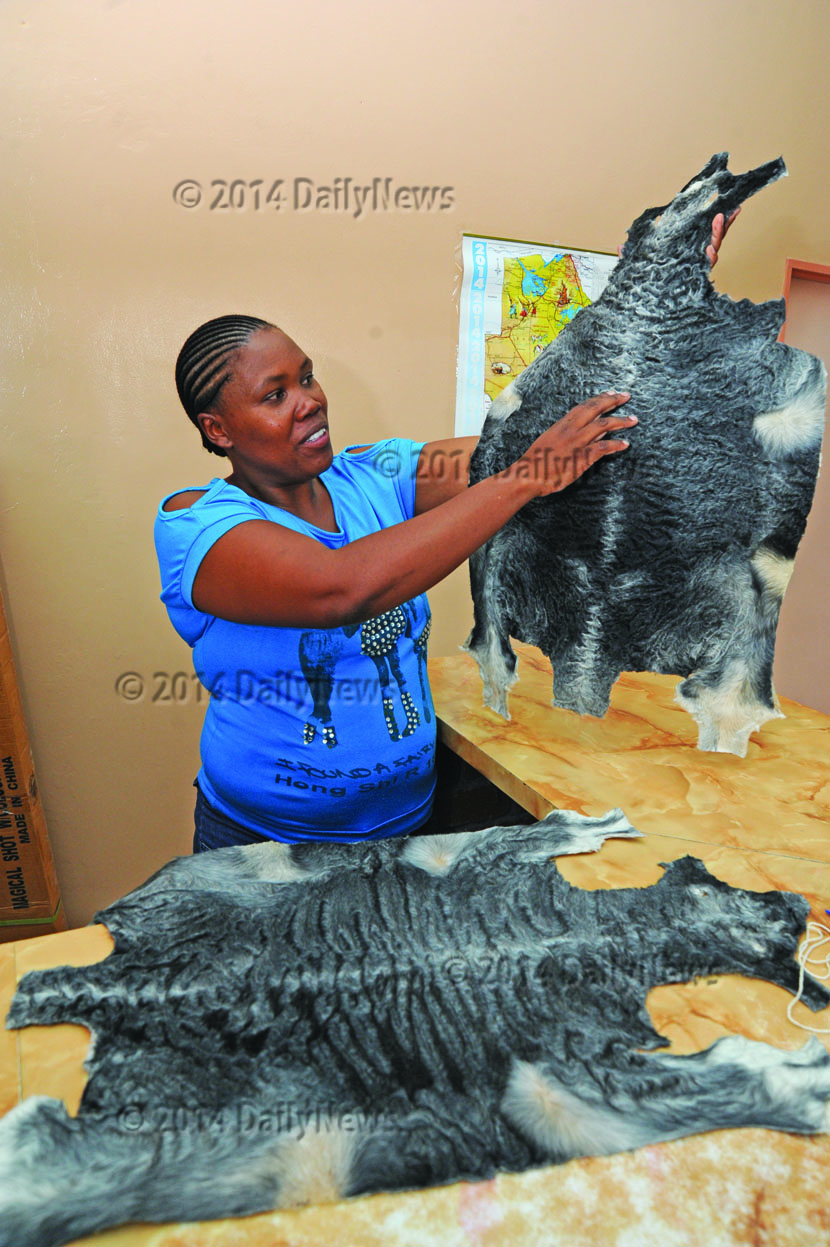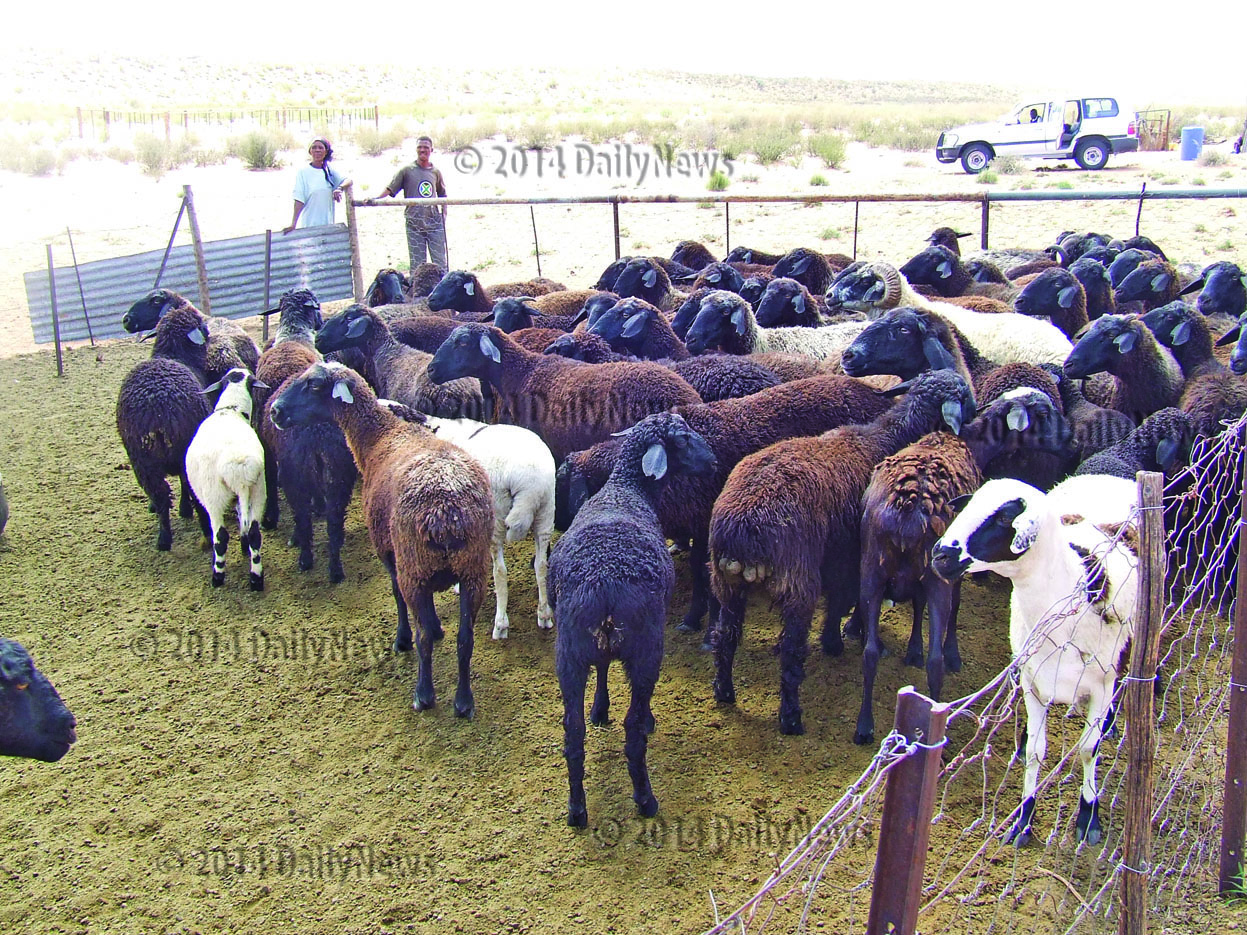Farmers plead for help
01 Apr 2014
Following collapse of the karakul market in Botswana back in the early 1980s, the fur fashion industry is more than ever in need of the quality skin produced from this rare breed of sheep.
The karakul sheep, a breed primarily raised for its fur, has regained popularity in recent years following the skin trade decline experienced in the 80s when China came up with alternative synthetic products.
Karakul farming collapsed dismally leaving a lot of farmers in the Kgalagadi District destitute, says Bokspits Multipurpose Cooperative chairperson, Ms Anna Strauss in an interview.
Thanks to the ever evolving fashion trends in the industry, top designers are now incorporating karakul pelts into their ready- to- wear collections primarily because of their light weight and comfortable nature.
Unless one is not a ‘fashionista’, karakul pelts (skin from karakul newly born lambs) have staged a comeback in a tremendous way as nowadays fashion runway shows are showing coats made of fur from karakul pelts.
Not only that, new trends show the fur incorporated in trims, skirts and suits. Many designers reportedly using karakul include Gucci, Dolce & Gabanna, Christian Dior, Givenchy and Valentino, among others.
Celebrity karakul wearers include, among others, Madonna, Lisa Marie Pressley, Sean “Puffy” Combs and designer Ralph Lauren.
At home, efforts were made in the 60’s to tap into the lucrative market. Ms strauss explains that farmers in the BORAVAST (Bokspits, Rapplespan, Vaalhoek, Struizendam) area, started farming karakul on a small scale in the 60’s.
“The production started in about 14 fenced farms and in those years, it was very good as it was also very easy to export pelts,” explains Ms Strauss.
At the time, says Ms Strauss, government came up with a policy stipulating that the pelts should be exported to Namibia through the Mamuno border post.
However, that posed a challenge for the farmers given low prices, which saw their dreams of cashing in on the highly prized pelts quashed as they switched to alternative breeds such as dorpers.
Dorpers were reared for meat production and unfortunately there is no small stock market in their area.
“It is expensive to transport small stock to Tsabong, Gaborone or Lobatse, as such we end up losing. Although government has opened borders, it is still expensive to sell to South Africa,” says Ms Strauss, explaining why small stock numbers are swelling in Kgalagadi.
Some farmers still do not want their pelts transported to Mamuno because they feel it is far, whereas South Africa is nearer. Nevertheless, Strauss explains that now that government is paying all the transportation fees from Botswana to Windhoek for free, farmers are happy.
“If we use the Gemsbok border post, we will need three permits for Botswana, Namibia and South Africa.”
Now that the karakul market is back on track, many farmers in the BORAVAST area are eager to start karakul farming again. Currently, the market demands 300 000 pelts per auction.
Auctions are held twice a year but the four farmers who are currently farming karakul sheep are far from meeting the demand as their combined output is between 200 and 250 per annum during marketing days.
Their greatest wish is that government should fund their take off. Ms Strauss says the Ministry of Agriculture is working on a policy to include karakul farming in the ISPAAD programme, especially to cater for farmers in their area as they cannot plough.
The Namibian Karakul Society has also visited the cooperative society to identify loopholes and whatever challenges farmers this side experience vowing to come up with solutions.
Ms Strauss further explains that Namibians want as many karakul farmers in Botswana as there possibly can be because South Africa and Namibia alone cannot satisfy the numbers that the market demands.
The CEDA route is said to be out of bounds as their loans take long to process and costs that come with the whole process are unbearable. Transport to travel to the nearest branch in Kanye is equally unreliable.
Mr Hendrik Esterhuizen is one of the remaining four farmers who are still pursuing karakul farming. When he started farming Karakuls in 1963, it was the only viable product in their area with a sustainable market.
With a loan from National Development Bank (NDB), he started with 50 black head pershian sheep. A karakul ram purchased in Namibia was brought to cross breed the initial herd. Mr Esterhuizen explains that when the herd is cross bred the second time, they become pure then the third time the flock can start producing pelts. New born karakul lambs are killed within 24 hours of their birth to preserve the gloss and curl of karakul fur, and then they are skinned and the skins are washed with salt and put on a tray under a shade to cool while they dry.
Seventy-two-year-old Esterhuizen explains that the pelts have to be packed under cool conditions after they are dry and then taken to the nearest agency.
The local farmers take the Karakul pelts to Bokspits Cooperative Society and then they are transported to Namibia where they are sorted according to colour and quality before they can be transported to Germany where the auction takes place.
Mr Esterhuizen, who farms at Welkom, says back in 1963 when he started the enterprise, the highest price for pelts was P55. When Namibia and all other colonies like England banned importation of karakuls to the European market, the prices plummeted and ultimately the collapse of the market in 1985.
He says their first market was in Europe. Eastwood and Walt companies bought the pelts from Namibia. By the time Namibia became independent in 1990 the Germans refused to auction the karakul pelts from Namibia. Instead the agency in Namibia collected the pelts and sent them to Germany for auction.
Mr Easterhuizen highlights that just like any other animal product, during transportation the pelts are quarantined for 30 days before they can be transported to the next country. Karakuls come in different shades of colours. “You get brown, black and white types with brown and black colouration being the most common,” says Mr. Easterhuizen.
He also says the white pelts are rare and highly priced. Black and brown pelts are bleached white during processing before they can be coloured to attain the desired quality and various shades of colours. Mr Easterhuizen explains that the bleaching process is very expensive. Therefore, the white ones do not need any bleaching hence the high price.
The average price he got for his pelts last year ranged from R800 with white ones selling for around R2 500. “I was lucky to get two (white pelts) of them there,” adds Mr Esterhuizen beaming with a smile. He says low qualities for white ones fetched R 1 200 last year each.
Texture is the most important characteristic of karakul pelts. Like a fingerprint, every karakul is unique.
Meticulous care is taken to produce lots that offer the manufacturer the highest degree of uniformity in size, fibre formation, length, weight, and quality and pattern excellence.
The most valued qualities, such as durability, silkiness, and shape of curls are all concentrated in black karakul sheep (www.swakara.net). In the fur trade, it is desirable that the curls be distributed uniformly. Pelts are matched for size of curl, pattern, luster, and other qualities.
Mr Easterhuizen also emphasises that great care is required to produce top quality karakul pelts. Even though karakuls thrive under extremely harsh living conditions like in the Kgalagadi area, they can survive severe drought conditions.
His flock browses on the veld preferring small bush like koegap and driedoring on top of the dune and grass plains.
During the dry season, they are given stock pellets while in winter they are supplemented with stock licks such as dicalcium, phosphate and salt. When the lambs are small, they are given lucerne because they cannot be left on the veld for fear of predators. He vaccinates every four months for botulism, pasturela, kidneys, ticks and lies. Sometimes one has to cut the hoofs and deworm, he adds.
“The hoofs are cut because the area is soft and they grow long,” he explains.
Mr Easterhuizen says karakuls can be reared in other areas as well because they are hardy and adapt easily. Also, relatively few inputs are required but he stresses that if they are to be reared in other areas, proper management style is needed.
In places where the bush is full of thick and thorny trees, their wool has to be kept short so that they do not get trapped by thorns. Karakuls are sheered every March and September.
In other areas, the sheering period will have to be changed, says Mr Esterhuizen, adding that they can be kept in smaller camps for shorter periods because they do not graze so much like dorpers.
At present, he has about 150 karakuls including three rams. He says he cannot keep large numbers because he is no longer energetic as he nears old age. He sold 58 last year. Good numbers are also dependent on whether the vegetation is good.
“Sometimes you have to cull all of them in dry periods and keep the ewes to survive,” he explains.
In normal periods, a farmer can keep 50 per cent for breeding and 50 per cent for pelts. A ram can be sold for P50 000 in Namibia and about P30 000 in South Africa.
Karakul farming is Mr Esterhuizen’s life. He was able to send his children to study abroad in countries such as Germany, England and Namibia with proceeds from pelts.
Besides karakuls, he also has 200 dorpers, 260 boer goats and more than 140 cattle which are all kept in three paddocks on a more than 2 000 hectare farm.
The farmer does not want to take anything for granted where karakul farming is concerned. He attends information days in South Africa. “There, we have a lot of information available to karakul farmers,” he says.
They learn what the markets look for, the quality and what the market pays for that quality and how to cross breed to get the best quality, he points out.
He is of the view that Kgalagadi farmers should be assisted with grants to start karakul farming to get out of poverty.
He says the market is lucrative and within 21 days after selling your pelts, the money comes directly into your account with no hassle. He stresses that in Namibia, they call it their diamond, and if taken seriously, karakul farming could be the next foreign income earner in the country. Ends
Source : BOPA
Author : Lindi Morwaeng
Location : BOKSPITS
Event : Interview
Date : 01 Apr 2014







